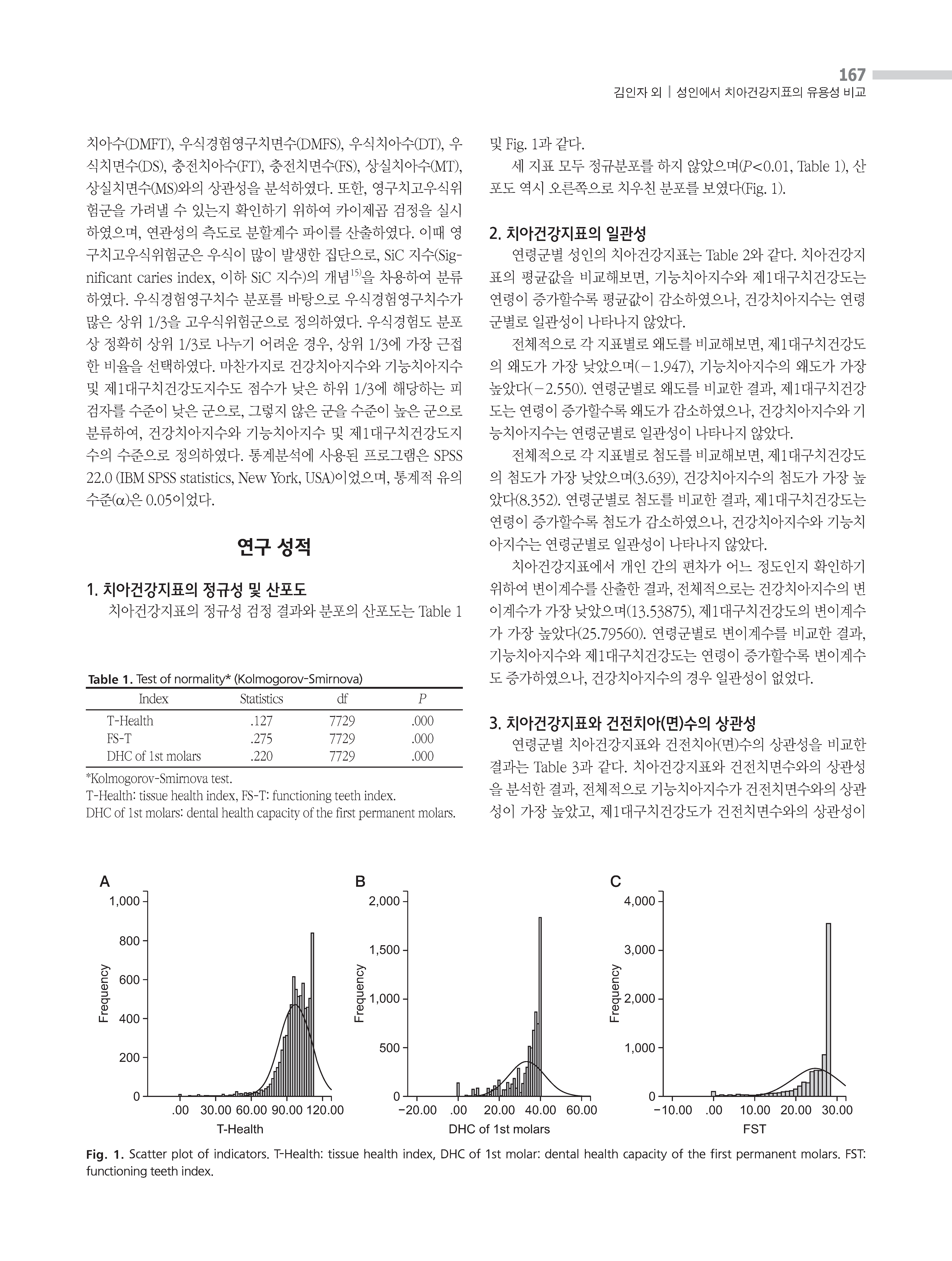Abstract
Objectives
The purpose of this study was to compare the value and utility of certain oral health indicators in adults.
Methods
The data used for analysis was obtained from the 6th Korean National Health and Nutrition Examination Survey (2013-2014). The study subjects were 7,729 adults aged between 20 and 64 years. The oral health indicators used for the analysis were T-Health (tissue health index), FS-T (functioning teeth index), and DHC of 1st molar (dental health capacity of the first molars). Descriptive statistical indices for oral health indicators were obtained (mean, skewness and kurtosis, and coefficient of variation). The correlation among oral health indicators, DMF, and sound tooth structure was analyzed.
Results
The oral health indicator scores had an abnormal distribution. DHC of 1st molar is found to be the most reliable indicator because it most accurately reflects the oral health decline that occurs as a result of aging. In all ages, DHC of 1st molar marked the lowest value in skewness and kurtosis. However, the skewness and kurtosis values of T-Health in adults younger than 44 years old were found to be the lowest among all age groups. FS-T is believed to most accurately reflect oral health status as it has a high correlation with sound tooth structure and sound tooth surfaces. T-Health is evaluated to most accurately reflect oral disease indicators as it appears to have a high correlation with DMF and high caries risk.
References
1. Lee MS. Looking at ‘well-being’ in terms of lifestyle: healthy or trendy? KJHE. 2004; 13:477–484.
2. Jung SH. New dental public health. Seoul: Komoonsa;2012. p. 20–22.
3. Jung SH. New dental public health. Seoul: Komoonsa;2012. p. 79.
4. Jung SH. New dental public health. Seoul: Komoonsa;2012. p. 72–75.
5. Sheiham A, Maizels J, Maizels A. New composite indicators of den-tal health. Community Dent Health. 1987; 4:407–414.
6. Cho NE, Kim MY, Yoo JH, Kim HS, Kwon HK, Cho YS, et al. New composite indicators for evaluating oral health in Korean adults: Functioning Teeth (FS-T) and T-Health Index. J Korea Acad Oral Health. 2006; 30:1–11.
7. Shin MS, Won YS, Gwon MY, Kim YS. A comparative study on DMFS, DMFT and FS-T indexes in the Korean elderly. J Dent Hyg Sci. 2010; 10:251–257.
8. Clune TW. A dental health index. J Am Dent Assoc. 1945; 32:1262–1269.
9. Lee SH, Lee HS, Oh HW, Ju HJ, Park SY. The utility of dental health capacity of the first permanent molars as an oral health indicator among children and adolescents. J Korea Acad Oral Health. 2015; 39:174–179.

10. Jakobsen JR, Hunt RJ. Validation of oral status indicators. Community Dent Health. 1990; 7:279–284.
11. Marcenes WS, Sheiham A. Composite indicators of dental health: functioning teeth and the number of sound-equivalent teeth (T-Health). Community Dent Oral Epidemiol. 1993; 21:374–378.

12. Lewis JM. Improving dental health status indicators for evaluation. Community Dent Oral Epidemiol. 1996; 24:32–36.

13. Benigeri M, Payette M, Brodeur JM. Comparison between the DMF indices and two alternative composite indicators of dental health. Community Dent Oral Epidemiol. 1998; 26:303–309.

14. Aleksejuniene J, Holst D, Eriksen HM. Patterns of dental caries and treatment experience in elderly Lithuanians. Gerodontology. 2000; 17:77–86.

15. Nishi M, Stjernswärd J, Carlsson P, Bratthall D. Caries experience of some countries and areas expressed by the Significant Caries Index. Community Dent Oral Epidemiol. 2002; 30:296–301.

16. Dawson AS, Smales RJ. Dental health changes in an Australian Defence Force population. Aust Dent J. 1994; 39:242–246.

17. Holtfreter B, Berg MH, Kocher T, Schiffner U, Hoffmann T, Mi-cheelis W. Change in FS-T index in adults in the German national oral health surveys between 1989 and 2005. Community Dent Oral Epidemiol. 2013; 41:251–260.

18. Bernabé E, Suominen-Taipale AL, Vehkalahti MM, Nordblad A, Sheiham A. He T-Health index: a composite indicator of dental health. Eur J Oral Sci. 2009; 117:385–389.
19. Bratthall D. Introducing the Significant Caries Index together with a proposal for a new global oral health goal for 12-year-olds. Int Dent J. 2000; 50:378–384.

20. Sung CJ, Kim JB. Study on the actual dental health capacity of the first permanent molars in the republic of Korea. J Korea Acad Oral Health. 1983; 7:21–36.
Fig. 1.
Scatter plot of indicators. T-Health: tissue health index, DHC of 1st molar: dental health capacity of the first permanent molars. FST: functioning teeth index.

Table 1.
Test of normality* (Kolmogorov-Smirnova)
| Index | Statistics | df | P |
|---|---|---|---|
| T-Health | .127 | 7729 | .000 |
| FS-T | .275 | 7729 | .000 |
| DHC of 1st molars | .220 | 7729 | .000 |
Table 2.
Change of dental health index scores
Table 3.
Correlation between oral health indicators and sound tooth (surface)
Table 4.
Correlation between oral health indicators
| Oral health indicator | T-Health | FS-T |
|---|---|---|
| T-Health | ||
| FS-T | .453** | |
| DHC of 1st molars | .736** | .526** |
Table 5.
Correlation between oral health indicators and oral diseases indicators
Table 6.
Relationship between high caries risk group and oral health indicatorsUnit : N (%)




 PDF
PDF ePub
ePub Citation
Citation Print
Print


 XML Download
XML Download